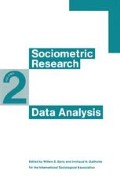Abstract
Dillman (1978) has developed a set of procedures, called the Total Design Method (TDM), to improve the quality of mail survey data. Most research on the efficacy of the TDM has been concerned with the response rate. Using the TDM Dillman (1978, p. 27) reports an average response rate of 70 per cent for samples from the general population of the United States. There is some evidence for the cross-cultural usefulness of the TDM. For instance, in The Netherlands, Hox, de Leeuw and Duijx (1984a) report a response rate of 71 per cent for a sample of the general population. Their study shows that, to achieve a response rate as high as this, the TDM has to be followed completely.1
Access this chapter
Tax calculation will be finalised at checkout
Purchases are for personal use only
Preview
Unable to display preview. Download preview PDF.
References
BRADBURN, N. M., SUDMAN, S., BLAIR, E. and STOCKING, C., ‘Question Threat and Response Bias’, Public Opinion Quarterly, 42 (1978) 221–34.
BRONNER, F., Telefonisch Onderzoek’, Methoden en Data Nieuwsbrief, 5 (1980) 145–56.
BRUINSMA, C. and SARIS, W. E., ‘Effects of Response Functions in Survey Interviews on Evaluation of Job Qualifications’, Kwantitatieve Methoden, 5 (1984) 87–109.
CBS: Central Bureau of Statistics, Statistisch Zakboek 1983 (Den Haag: Staatsuitgeverij, 1983).
COOK, T. D. and CAMPBELL, D. T., Quasi Experimentation: design and analysis issues for field studies (Chicago: Rand McNally, 1979).
DIJKSTRA, W., Beinvloeding van Antwoorden in Survey-interviews (Delft: Bouwplatenwerkplaats, 1983).
— and ELSINGA, E., ‘Respondent-rolopvattingen in Survey-interviews’, Mens en Maatschappij, 3 (1981) 311–17.
— and ZOUWEN, J. van der (eds), Response Behaviour in the Survey Interview (London: Academic Press, 1982).
DILLMAN, D. A., Mail and Telephone Surveys (New York: Wiley, 1978).
ELSHOUT, J. J. and AKKERMAN, A. E., ‘Een Nederlandse test voor vijf persoonlijkheidsfactoren, de 5 PFT’, in DRENTH, P. J. D. and WOLFF, Ch. J. de (eds) Arbeids — en organisatiepsychologie (Deventer: Kluwer, 1973).
FEY, J. A., Temparement, een onderzoek naar de betekenis van extraversie, impulsiviteit en spanningsbehoefte (Lisse: Swets, 1979).
FLIER, H. van de, Vergelijkbaarheid van individuele testprestaties (Lisse: Swets, 1980).
HART, H., ‘t Selectie en zelfselectie van Informanten in enquetes, Dissertation (University of Amsterdam, 1974).
HIPPLER, H. J. and SEIDEL, K., Schriftliche Befragung bei Algemeine bevölkerings-stichproben — Untersuchungen zur Dillman’sehen ‘Total Design Method’, ZUMA-Nachrichten (Mannheim: ZUMA, 1985).
HOX, J. J., LEEUW, E. D. de and DUIJX, A. W. M., ‘The Postman Rings Thrice’, Mens en Maatschappij (1984a). (An English version is available as: HOX, J. J., LEEUW, E. D. de and DUIJX, A. W. M., ‘The Postman Rings Thrice: the effect of personalizing and using certified mail on the response in mail surveys’ (Amsterdam: University of Amsterdam, Department of Education, 1984b).
Inter/View groep, Rondje Nonresponse (Amsterdam: Inter/View groep, 1978).
JONES, W. H. and LANG, J. R., ‘Sample Composition Bias and Response Bias in a Mail Survey: a comparison of inducement methods’, Journal of Marketing Research, 17 (1980) 69–76.
JONG-GIERVELD, J. J. de and KAMPHUIS, F. H., ‘The Development of a Rasch-type Loneliness Scale’, in Multivariate Analysis in the Social and Behavioural Sciences (Amsterdam: SISWO, 1983) 65–91.
LEEUW, E. D. de and HOX, J. J., Artifacten bij postenquetes: de gebruikte instrumenten (University of Amsterdam: Subfaculteit Opvoedkunde and Subfaculteit Sociologie, 1984).
McGUIRE, W. J., ‘Suspiciousness of Experimenter’s Intent’, in ROSENTHAL, R. and ROSNOW, R. L. (eds), Artifact in Behavioral Research (New York: Academic Press, 1969).
MOKKEN, R. J., A Theory and Procedure of Scale Analysis (Den Haag: Mouton, 1970).
MOLENAAR, I. W., ‘Some Improved Diagnostics for Failure of the Rasch Model’, Psychometrika, 48 (1983) 49–72.
NEDERHOF, A. J., Some Sources of Artifact in Social Science Research: nonresponse, volunteering, and research experience (Dissertation, University of Leiden, Leiden, 1981).
PHILLIPS, D. L., Knowledge from What? (Chicago: Rand MacNally, 1971).
RASCH, G., Probabilistic Models for Some Intelligence and Attainment Tests (Copenhagen: Danish Institute for Educational Research, 1960).
ROOIJEN, L. van, ‘Problem Drinking among Students in a Dutch University’, Gezondheid en Samenleving, 2 (1981) 65–77.
ROSENTHAL, R. and ROSNOW, R. L., Artifact in Behavioral Research (New York: Academic Press, 1969).
— and — The Volunteer Subject (New York: Wiley, 1975).
SCR, Social and Cultural Report 1980 (Den Haag: Staatsuitgeverij, 1981).
SUDMAN, S. and BRADBURN, N. M., Response Effects in Surveys: review and synthesis (Chicago: Aldine, 1974).
TATSUOKA, K. K. and TATSUOKA, M. M., ‘Spotting Erroneous Rules of Operation by the Individual Consistency Index’, Journal of Educational Measurement, 20, 3 (1983) 221–30.
TULDER, J. J. M. van, ‘Op de grens van de non-response I’, in Jaarboek van de Nederlandse Vereniging van Marktonderzoekers (Amsterdam, 1977).
— ‘Op de grens van de non-response II’, in Jaarboek van de Nederlandse Vereniging van Marktonderzoekers (Amsterdam, 1978).
TURNER, C. B. and FISKE, D. W., ‘Item Quality and Appropriateness of Response Processes’, Educational and Psychological Measurement, 28 (1968) 297–315.
Editor information
Editors and Affiliations
Copyright information
© 1988 Willem E. Saris and Irmtraud N. Gallhofer
About this chapter
Cite this chapter
de Leeuw, E.D., Hox, J.J. (1988). Artifacts in Mail Surveys: the Influence of Dillman’s Total Design Method on the Quality of the Responses. In: Saris, W.E., Gallhofer, I.N. (eds) Sociometric Research. Palgrave Macmillan, London. https://doi.org/10.1007/978-1-349-19054-6_3
Download citation
DOI: https://doi.org/10.1007/978-1-349-19054-6_3
Publisher Name: Palgrave Macmillan, London
Print ISBN: 978-1-349-19056-0
Online ISBN: 978-1-349-19054-6
eBook Packages: Palgrave Social & Cultural Studies CollectionSocial Sciences (R0)

